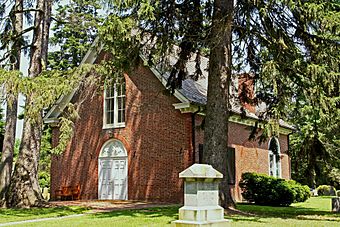St. Paul's Church (Fairlee, Maryland) facts for kids
Quick facts for kids |
|
|
St. Paul's Church
|
|

St. Paul's Episcopal Church
|
|
| Location | 7579 Sandy Bottom Rd., Chestertown, Maryland |
|---|---|
| Nearest city | Chestertown, Maryland |
| Area | 12 acres (4.9 ha) |
| Built | 1711-1713 |
| Architectural style | Georgian |
| NRHP reference No. | 80001820 |
| Added to NRHP | June 6, 1980 |
St. Paul's Church is a very old and important Episcopal church located near Fairlee, close to Chestertown, in Kent County, Maryland. It is one of the first thirty churches created in Maryland way back in 1692. That's when the Church of England became the official religion of the Maryland colony. The church building you see today was finished in 1713. It's built in the Georgian style and is the second-oldest Episcopal church on the Eastern Shore of Maryland.
Contents
A Look Back: The History of St. Paul's Church
Building the First Churches
St. Paul's Parish was created by a law in 1692. The church leaders, called the vestry, met for the first time in January 1693. They decided how the first church building would be made. Daniel Norris built this first church. It cost twenty-one thousand pounds of tobacco! It was finished by 1696.
In 1711, a new leader, Rev. Alexander Williamson, came to St. Paul's. The church leaders then hired James Harris to build a brand new brick church. This new church was planned to be 40 feet long and 20 feet wide. It would be 16 feet tall with five windows and two doors. The walls were very thick, made of bricks.
The Church We See Today
The new church cost seventy thousand pounds of tobacco and took two years to build. On April 6, 1713, James Harris finished the new St. Paul's Church. Over the next two years, the inside of the church was plastered. It also got thirty-four pews, a pulpit, and a reading desk. The floors were laid with bricks in a cool herringbone design.
A special building called the Vestry House was built in 1766. This was a common building for churches back then, but now only two of them are left in Maryland. The other one is at St. George's Church.
St. Paul's Church, opened in 1713, is still used today. It is the oldest church building in Maryland that has been used continuously. The church is about 30 feet by 40 feet. It has a rounded area at the east end where musicians used to sit. The floor was not raised like it is now, and there was no altar. People sat in "box pews" on chairs and faced the pulpit, which was in the middle of the north wall. The main door was on the south wall.
Important Leaders and Changes Over Time
Many important people served as leaders at St. Paul's Church. One was Rev. James Sterling, who was a poet and a playwright. He also collected customs taxes for Chestertown.
Another important leader was Rev. William Smith. He became the church leader in 1779. Rev. Smith helped start Washington College. He also led a meeting in 1780 where the Episcopal Diocese of Maryland was formed. This helped St. Paul's Church stay open after the American Revolutionary War.
After the war, St. Paul's Church faced some tough times. By 1840, only thirteen families were part of the church. But new leaders in the mid-1800s helped the church grow again. In 1841, a new vestry (a room for church leaders) was added. The inside of the church got new pews. The church was also changed to focus more on the sacrament, which was part of a movement called the Oxford Movement.
St. Paul's Church was officially dedicated again on November 26, 1843. During the American Civil War, a special stained-glass window was put in above the altar. It used colors and symbols that later became part of the Maryland State Flag. This window was a symbol of unity during a time when people had different feelings about the war.
Growth and Modern Times
St. Paul's Church continued to do well in the late 1800s. Rev. Sewell S. Hepburn was a leader there from 1874 to 1881. He was the grandfather of the famous actress Katharine Hepburn. Another important leader was Rev. Christopher Denroche, who came from Canada in 1892. He stayed until he passed away in 1906.
Rev. Denroche wrote a book about the church's history in 1893 for its 200th birthday. He also did research that led to a monument for the Battle of Caulk's Field. This battle happened on August 30, 1814, and was the only battle in Kent County during the War of 1812. More improvements were made to St. Paul's Church, including a cast iron chandelier in 1882, a marble altar in 1890, and stained glass windows in 1912.
In the 1900s, St. Paul's Parish added more buildings around the historic church. A new parish hall and rectory (the home for the church leader) were added in 1948. These were designed by Bryden Hyde, whose family was connected to an earlier church leader. In 1967, the vestry was made larger, and more improvements were done to the church.
St. Paul's Church was added to the National Register of Historic Places in 1980. The church celebrated its 300th birthday in 1992 with a year-long festival. A special visitor from Canterbury Cathedral in England even came to join the celebration.





